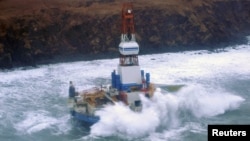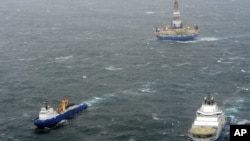The runaway oil rig that ran aground in Alaska on New Year's Eve dragged the two vessels trying to control it more than 10 miles (16 kilometers) shorewards in just over an hour before the crews cut it loose to save themselves in "near hurricane" conditions.
Details were still emerging on Wednesday from Coast Guard officials and Royal Dutch/Shell, the company at the center of a highly controversial and accident-prone Arctic oil drilling program of which the Kulluk was a part.
They paint a frightening picture of the 28,000-ton, saucer-shaped drillship being tossed towards the shore on waves up to 11 meters high driven by winds up to 100 kph, pulling its main support vessel, the Aiviq, and a tug, the Alert, behind it.
"We are talking about near hurricane-strength conditions," said Darci Sinclair, an official of the Kulluk Tow Incident Unified Command, set up by the U.S. Coast Guard and the companies involved. "Regaining control became extremely challenging."
On Wednesday, an update from the unified command said the Kulluk was still aground on Sitkalidak Island in the Gulf of Alaska, but was "upright and stable". It plans a number of flyovers of the site during the day. Updates were available at www.kullukresponse.com.
The 30-year-old Kulluk is operated by Noble Corp and was refitted by Shell for its summer 2012 drilling expedition in the Beaufort Sea off northern Alaska.
Shell has spent over $4.5 billion on preparation for extraction activities there and in the Chukchi Sea further east, but has yet to complete a single well, and has suffered a number of embarrassing setbacks.
2013 headlines that raise questions about the wisdom of drilling so far north in such a remote, environmentally-delicate and technically-challenging place, were not expected so early in the year, because activity stopped for the season two months ago.
The Kulluk was on its way south for the winter. It had been towed east from the Beaufort Sea on Alaska's northern coast, and then south through the Bering Strait that separates the northernmost U.S. state from Siberia.
On Dec. 28, around halfway to its winter destination in Seattle, and about 50 miles off the south coast of Kodiak island in the Gulf of Alaska, engine failure struck the towing vessel Aiviq - a state-of-the-art icebreaker that is just a few months old, and whose name means "Walrus".
The weather was already rough and the drillship's 18-strong crew were lifted off, and a doomed four-day battle to keep the Kulluk off the rocks began.
As weather conditions worsened, the operation ran into deeper difficulty a few hours after nightfall on December 31, with the shoreline less than 19 miles away.
Aiviq, one of two vessels that were attached at the time, lost its line. It was re-attached, and battled on against the elements along with the Alert, but the coast kept getting closer as the storm blew all three vessels northeastwards.
At 2015 (Jan. 1, 0515 GMT), the order was given to cut the lines to the Kulluk to save the Aiviq, the Alert, and their crews.
At 2030, the lines were cut, and by 2048, a trajectory map on the unified command website shows, the Kulluck was aground about 1,600 feet from the shore on Sitkalidak Island, near the larger Kodiak Island. The Kulluk, the wind, and the waves had dragged Aiviq and Alert more than 10 miles in just over an hour.
The vessel settled on what one Coast Guard official described as "loose rock and sand."
Noble had no immediate comment. Shell in London has made a series of statements confirming the progress of the operation, but had nothing to add on Wednesday, and referred calls to the unified command. Shell in Houston could not immediately be reached for comment.
But opponents of Arctic drilling were quick to hold the accident up as an example of Shell's inability to keep the Arctic safe, even though the spill risk from the drillship is limited to the 143,000 gallons of ultra-low-sulfur diesel and 12,000 gallons of other oil products on board.
On Wednesday, Greenpeace joined the chorus of criticism.
"Shell has lurched from one Arctic disaster to the next, displaying staggering ineptitude every step of the way. Were the pristine environment of the frozen north not at risk of an oil spill it would be almost comical. Instead it's tragic," said campaigner Ben Ayliffe. "We're moving closer to a major catastrophe in the Arctic and the U.S. government appears unwilling to provide either the needed oversight or emergency backup the company's incompetence requires."
The U.S. Coast Guard said on Tuesday that the Kulluk's hull appeared sound after a few overflights.
Shell's Arctic campaign has been bedevilled by problems. A second drillship, the Noble Discoverer, was briefly detained in December by the Coast Guard in Seward, Alaska, because of safety concerns. A mandatory oil-containment barge, the Arctic Challenger, failed for months to meet Coast Guard requirements for seaworthiness, and a ship mishap resulted in damage to a critical piece of equipment intended to cap a blown well.
Asked about why the Kulluk was still at sea two months after ending its drilling program, a reliable contract drilling source said the standard "demobilization" process that follows drilling programs can take days or weeks depending on the model of rig and how it is anchored.
It is also possibile that the weather was rough enough over the last few months to delay transit. The availability of the towing vessel and crew could also be a factor.








